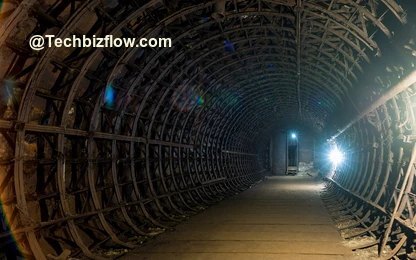Why Fallout Shelter Technology Matters Today
In today’s world of rising uncertainties from climate alter and worldwide pandemics to geopolitical pressures and atomic threats, the significance of a secure, economical, and savvy aftermath shield cannot be exaggerated.
What was once a Cold War-era concept has changed into a cutting-edge, innovative wonder, combining security with development.
This direct investigates how current progressions have revolutionized aftermath shield innovation, making survival in extraordinary conditions not as it were conceivable but also comfortable.
The History of Fallout Shelters: From Cold War to AI Age
Fallout shelters were, to begin with, presented amid the Cold War as a protective measure against atomic attacks. Governments built open cover, whereas private citizens started developing their own.
- 1950s – 1970s: Aftermath covers fundamentally comprised of concrete bunkers prepared with fundamental supplies.
- 1980s – 2000s: Intrigued disappeared as worldwide pressures decreased.
- Post-2010: A resurgence happened due to characteristic fiascos, fear-based oppression, and pandemics.
Today, Tech-driven plans, maintainability, and mechanization characterize present-day aftermath shelters.
The Technology Evolution Behind Fallout Shelters
Modern aftermath covers are implanted with cutting-edge technology:
- Materials Building: Progressed cover, radiation-blocking concrete, and composite materials.
- IoT Integration: Shrewd sensors for temperature, mugginess, gas, and radiation detection.
- Renewable Vitality: Sun oriented boards, wind turbines, and cross breed systems for control generation.
- Communication Frameworks: Secure, scrambled frameworks for outside communication.
Core Technologies That Power a Modern Fallout Shelter
A. Air Filtration Systems
Innovations include:
- HEPA Filtration: Expels 99.97% of particles.
- NBC Channels: Outlined to kill Atomic, Organic, and Chemical contaminants.
- UV-C Sterilizers: Neutralize airborne infections and bacteria.
- Airlocks: Avoid sullied discuss from entering.
B. Water Purification and Recycling
Water frameworks have advanced to be effective and safe:
- Reverse Osmosis: Exceedingly compelling in expelling impurities.
- UV and Ozone Medications: Slaughters pathogens.
- Rainwater Gathering: Gather and store clean water.
- Greywater Reuse: Reuses water from basins and washing for non-drinking purposes.
C. Power and Energy Storage
Power is basic for running frameworks interior a shelter:
- Solar Boards: Diminish reliance on fossil fuels
- Lithium-ion Batteries: Store vitality for backup.
- Diesel Generators: Give crisis power.
- Energy-efficient Gadgets: Decrease control consumption.
D. Food Storage and Agriculture Technology
Feeding a family for months requires keen nourishment solutions:
- Freeze-Dried Nourishments: 25+ year rack life.
- Hydroponics: Soil-free farming.
- Aquaponics: Angle and plant co-existence system.
- Smart Refrigeration: App-controlled climate and alerts.
E. Waste Management Systems
Waste frameworks anticipate defilement and disease:
- Composting Toilets: Turns squander into usable compost.
- Biogas Frameworks: Change waste into energy.
- Waterless Toilets: Diminish reliance on the water supply.
- Incinerators: High-tech burning of squander materials.
Smart Shelter Integration: Automation, Monitoring & AI
- Shelter Administration Frameworks (SMS): Centralized control boards for all systems.
- Real-Time Checking: Tracks natural and auxiliary parameters.
- AI Integration: Predicts support and risk.
- Voice Associates: Alexa and Google integration for hands-free control.
Fallout Shelter Communication Technologies
Communication is vital amid emergencies:
- Satellite Phones: Work without neighborhood towers.
- HAM Radios: Dependable and durable.
- Signal Boosters: Guarantee solid gathering underground.
- Mesh Systems: Nearby communication without internet.
Designing Your Fallout Shelter with Modern Technology
The shelter plan is presently more tech than fair structure:
- Digital Reenactments: Utilization of BIM and AutoCAD for 3D modeling.
- Biometric Get to: Unique finger impression and facial recognition.
- EMP-Resistant Cabling: Secure gadgets from electromagnetic pulses.
- Virtual Reality (VR): Reenact crisis scenarios for training.
Commercial Fallout Shelter Providers Using Advanced Technology
Several companies lead the high-tech aftermath protection industry:
- Rising S Company: Custom covers with full automation.
- Atlas Survival Covers: Offers NBC filtration and EMP protection.
- Vivos Gather: Underground communities with AI monitoring.
All join renewable vitality, discuss filtration, and progressed squander management systems.
How Much Does a Modern Fallout Shelter Cost in 2025?
Prices change broadly based on features:
- Basic: $50,000 – $100,000
- Mid-tier: $100,000 – $300,000
- Luxury: $500,000+
Case Studies: Real People Using Fallout Shelter Technology
- Tech CEOs: Underground covers with Starlink, VR, and AI.
- Rural Preppers: Solar-powered bunkers with hydroponic farms.
- Families: Fundamental savvy covers with discuss and water systems.
These real-life illustrations show how changed and versatile shield innovation has become.
Fallout Shelter Mobile Apps & Software
Mobile innovation plays a key part in checking shelters:
- ShelterTracker: Oversees nourishment, water, and energy.
- VaultAlert: Sends crisis alerts.
- RemoteControl: Works HVAC, lighting, and cameras.
Preparing for the Worst: When Fallout Shelter Tech Saves Lives
- Nuclear Occasions: Fixed discuss and radiation channels ensure occupants.
- Pandemics: Sterile environment with controlled discuss and surface contact.
- Natural Catastrophes: Auxiliary flexibility and long-term sustainability.
- Civil Distress: Inaccessible communication and reconnaissance give safety.
Supporting Health and Comfort with Technology
Well-being is pivotal amid amplified protective measures:
- LED Lighting: Imitates characteristic light for circadian rhythm.
- Air Quality Screens: Keep up a breathable atmosphere.
- Fitness Hardware: Keen treadmills and resistance bands.
- Mental Wellbeing Apps: Contemplation, VR travel, and online therapy.
Ethical and Social Considerations
- Access Value: Who can bear shrewd shelters?
- Government Control: Guaranteeing security and legality.
- Privacy: Information collected through protective sensors.
- Social Duty: Advancing communal shelters.
Future Trends in Fallout Shelter Technology
The following decade will indeed bring more innovations:
- Autonomous Covers: Completely self-regulated survival units.
- Quantum Communication: Ultra-secure protected links.
- AI-Powered Diagnostics: Framework wellbeing checks.
- Blockchain Get to: Secure and decentralized passage logs.
- Nano Materials: Super-insulation and lightweight strength.
Conclusion: Technology is the New Key to Survival
Fallout shield Technology has come a long way. It’s no longer almost only surviving; it’s about living keenly and securely in any circumstance.
From progressed filtration frameworks and renewable energy to AI and IoT integration, advanced aftermath covers are innovative powerhouses.
As dangers advance, so must our solutions, and the shrewd protector is the extreme image of 21st-century resilience.
Whether you’re building a fundamental bunker or a high-tech alcove, contributing to the right innovation is the most astute frame of survival planning you can do in 2025 and beyond.
FAQs
What is a fallout shelter with modern technology?
A secure, protected upgrade with discussion channels, solar control, and smart systems.
What tech is essential in a fallout shelter?
Key tech incorporates discuss decontamination, water reusing, and AI monitoring.
How much does a high-tech aftermath cost?
Costs run from $50,000 to over $500,000 based on features.
Can ancient aftermath covers be upgraded?
Yes, they can be retrofitted with shrewd vitality, filtration, and security tech.
Is it legitimate to construct aftermath covers at home?
Yes, but continuously follow neighborhood building codes and permits.


